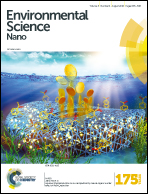Spectral characterization and surface complexation modeling of low molecular weight organics on hematite nanoparticles: role of electrolytes in the binding mechanism†
Abstract
Given the ubiquity of organic–metal oxide interfaces in environmental and medical systems, it is necessary to obtain mechanistic details at the molecular level from experimental procedures that mimic real systems and conditions. We report herein the adsorption pH envelopes (range 9–5), isotherms at pH 7, and H/D exchange spectra using attenuated total internal reflectance Fourier transform infrared spectroscopy (ATR-FTIR) for citrate, oxalate and pyrocatechol on hematite nanoparticles. Experimental data were coupled with the application of triple layer surface complexation models derived for each organic compound based on the interpretation of spectral data. These studies showed that the structure of the organic species influences the type and relative amounts of inner- versus outer-sphere surface complexes. This has consequences on the surface charge as shown from electrolyte concentration-dependent studies. For example, citrate forms a mix of protonated monodentate inner-sphere complexes with one negative charge and deprotonated outer-sphere complexes with net two negative charges. Oxalate forms mostly doubly deprotonated outer-sphere complexes with inaccessible neighboring sites with contributions from deprotonated inner-sphere complexes. Lastly, pyrocatechol forms mostly bidentate inner-sphere complexes. Layering of interfacial electrolyte ions from KCl, NaCl and KBr, used to adjust the electrolyte concentration, caused an overall enhancement in the amount of adsorbed weakly-bonded citrate and oxalate. Also, hematite nanoparticles retain more adsorbed citrate and pyrocatechol than adsorbed oxalate when chloride or bromide was flowed as a negatively-charged weak desorbing agent at pH 7. These results have implications for the overall surface chemistry of hematite nanoparticles in the presence of organic matter, particularly those containing carboxylate and phenolate functional groups.


 Please wait while we load your content...
Please wait while we load your content...